Day in Fishguard
The Last Invasion Tapestry Gallery
Town Hall, Market Square | Just off public library in gallery on first floor, Fishguard, Wales
The Last Invasion of Britian -April - September
Monday - Wednesday: 10:00am - 5:00pm Thursday: 10:00am - 6:00pm- Friday: 10:00 - 5:00pm
Saturday: 10:00am - 4:00pm
Saturday: 10:00am - 4:00pm
When one of the French ships entered Fishguard Bay, the alarm was raised and one of the “Fishguard Volunteers” rushed to Tregwynt Mansion to alert Lieutenant Colonel Thomas Knox who was dining there. At first he gave it little credence, but as the seriousness of the situation dawned on him he instructed volunteers to make for the Fort. Lord Cawdor set off from Haverfordwest to reinforce Knox.Following the landing, the French had moved a further two miles inland and occupied two strong defensive positions at Garnwnda and Garngelli.
Thus far all had gone well for Tate. Knox being heavily outnumbered, abandoned Fishguard .
Knox and his men met reinforcements at Trefgarne, and Lord Cawdor led the forces back towards Fishguard. By this time Tate’s fortunes had changed . Many of the foraging parties resorted to pillaging local farms and Llanwnda Church. French orders had instructed Castagnier’s squadron to sail away leaving the soldiers isolated, with no means of escape and increasingly demoralised.
Meanwhile British Soldiers were gathering at Fishguard where the officers were stationed overnight in what is now called the Royal Oak Inn. The local heroine, Jemima Nicholas, is said to have captured soldiers single-handedly and secured them in St Mary’s Church.
That evening, two French delegates arrived at the Royal Oak to negotiate a conditional surrender. But Cawdor, with magnificent bluff, replied that with his superior numbers he would only accept an unconditional surrender, otherwise the French would be attacked. The following morning the British forces were lined up in battle order, reinforced by hundreds of civilians to await Tate’s response. Tate accepted the terms and finally with drums beating, the French marched down to Goodwick Beach, where they stacked there weapons.
The MythThere is strong evidence to support the story that the French were deceived into thinking they were facing a large British army when they saw red and black movements in the distance. In truth, these were said to be local women in traditional red shawls and black hats marching around a prominent hill in Fishguard – The Bigney – now covered in houses.
The Tapestry
The Last Invasion Embroidered Tapestry is 30 metres / 100 feet long by 53cm / 21 inches deep and took four years to complete. It was commissioned by the Fishguard Arts Society as a permanent legacy of the Bicentenary Commemorations. It is now owned by a charitable trust – Fishguard Invasion Centre Trust Ltd.
The Tapestry was designed by Elizabeth Cramp and the embroidery advisers were Rozanne Hawksley, Eirian Short and Audrey Walker. Seventy-seven local people helped to make it. It was designed in a simple format and is the same depth as the Bayeux Tapestry, (which tells the story of the 1066 Norman Invasion). The embroidery stitches are mostly the same as those used by the medieval embroiderers. 178 shades of crewel wool were used and subtle colour changes indicate late winter days, night-time or candle light.
Historical facts and popular legends combine with Elizabeth Cramp’s sense of humour and eye for detail to provide an imaginative interpretation of a little known, but significant, moment of Welsh and British history.
How It Was Made
Design work started in 1993, when Elizabeth Cramp was asked to design a 100 foot long by 20 inches deep embroidery, depicting the 1797 invasion of West Wales by the French. It was planned as a community project to celebrate the bicentenary of that event, in 1997. Elizabeth Cramp researched the history of the event which she then drew onto a quarter-size cartoon in soft 4b pencil. The next stage was using 3 rolls of paper to convert the quarter-size design to the full size cartoon.
The Invasion Tapestry was worked on a natural cotton which looked like linen. For the Tapestry Appleton’s Crewel Wool was used; it is moth-proofed, does not fade and comes in hundreds of shades. It is a fine thread so that one, two, three or more strands can be used in a needle. The Tapestry was worked as 37 separate, manageable sized panels which were joined together afterwards. Simple wooden frames were made and the fabric stretched and stapled over the frames. To transfer the design to the fabric a careful tracing was made from Elizabeth’s painting on to ordinary tracing paper. Dressmaker’s tracing carbon was placed between the fabric and this tracing. Using pens it was then transferred to the fabric. These faint carbon lines where then “inked over” using a very fine waterproof drawing pen.
All the embroiderers were women ranging in age from around thirty to eighty-two years old. The embroiderers organised themselves into groups who would work together on their panels in their own homes. A local builder’s merchant donated suitable wood and Philip Chivers and Denys Short constructed the frames. By December 1994 there were 12 panels ready, complete with instruction charts and allocated wools. Meetings were called from time to time so that embroiderers could compare notes and share ideas.
In the Autumn of 1996 the tapestry came together in one piece and the “overlap” embroidery was completed. In January 1997 a cotton lining was hand sewn to the Tapestry, ready for display.
The Tapestry was unveiled to the public on February 22nd 1997 – the bicentenary of the date the French forces landed at Carreg Wastad.
Fishguard Fort
HERITAGE HIGHLIGHTS: Played a part in the Last Invasion of Britain in 1797
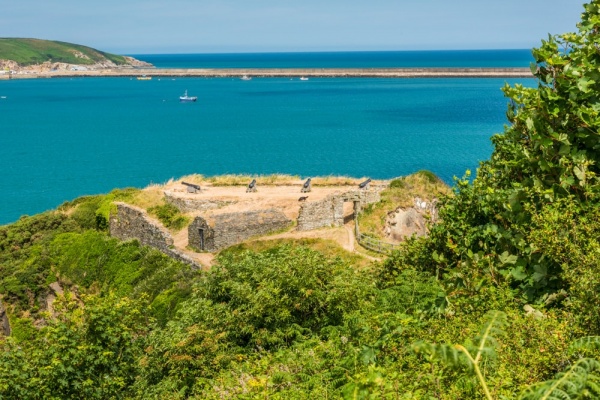
Fishguard Fort from the coastal path
Fishguard Fort is an 18th-century fortification on the rocky promontory of Castle Point, overlooking Fishguard Harbour to the south-east. In a roundabout way, the fort owes its existence to a pirate, and to the American War of Independence.
History
In 1779 an American privateer named the Black Prince captured a local ship and demanded a ransom of 1000 pounds from the townsfolk of Fishguard. The Black Prince and its captain, Stephen Manhant, were commissioned by the US government to attack British targets, as part of their efforts to gain independence from Britain.Manhunt was a native of Boston, but the Black Prince sailed under a French flag, in support of the American revolutionary efforts. The Black Prince was very successful as a privateer, destroying more than 30 British ships over the course of three months.
The townsfolk of Fishguard refused to buckle, however, and rejected Manhunt's demands for a ransom. The Black Prince responded by bombarding the town, damaging St Mary's Church and several houses. A local ship fired back, followed by cannon fire from the shore. Manhunt decided it wasn't worth the trouble, and the Black Prince sailed away.
To prevent similar attacks in the future, an artillery fort was built on Castle Point, at the eastern approach to the harbour. Fishguard Fort was completed in 1781, just two years after the attack.
The fort was armed with eight 9-pounder cannons. It was manned by three invalided gunners from Woolwich, London. The fort later became the headquarters for the local militia, known as the 'Fishguard Fencibles'.
The Last Invasion of Britain
On 22 February 1797 a French invasion force appeared off the Welsh coast. The garrison of Fishguard Fort fired blanks to warn of the French approach, conserving their small supply of cannon balls.
The sound of the cannon fire convinced the French to avoid Fishguard harbour, and they sailed further south along the coast to Strumble Head before landing.
The peculiar story of what happened next is told in the Fishguard Last Invasion Tapestry in the Fishguard library. The traditional story is that the French ravaged the countryside for a few days, burning farms and pillaging where they could. The local militia gathered quickly and forced the French to surrender.
In one famous - and probably imaginary episode - a local woman named Jemima Nicholas captured a dozen French soldiers single-handedly, armed only with her pitchfork. The French soldiers may have mistaken local women wearing their traditional tall black hats and long red cloaks for Grenadier Guards, and surrendered before they realised their mistake.
The Last Invasion was the only action that the fort ever faced. The fort continued to be manned until the early 19th century, but was then allowed to decay.
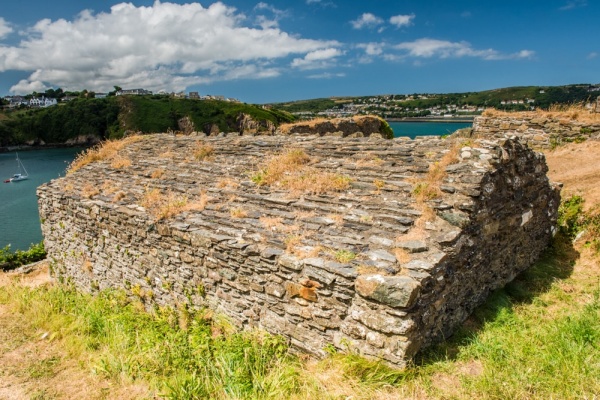
The ammunition storehouse
What to See
The fort occupies a small, relatively flat area on the top of Castle Point. The site is roughly 30m from east to west and 25m north to south. It is composed of a single gun battery facing north and west along the coast. A simple curtain wall runs across the promontory neck, pierced by a single arched opening.
Within the fort is a rectangular vaulted ammunition storehouse set into the hillside. At the far end of the vaulted chamber is a small area where gunpowder was stored.
There are four restored cannons mounted on the gun battery, but what really makes Fishguard Fort worth visiting is the wonderful coastal scenery, with marvellous panoramic views over Fishguard Harbour and Goodwick on the far shore.
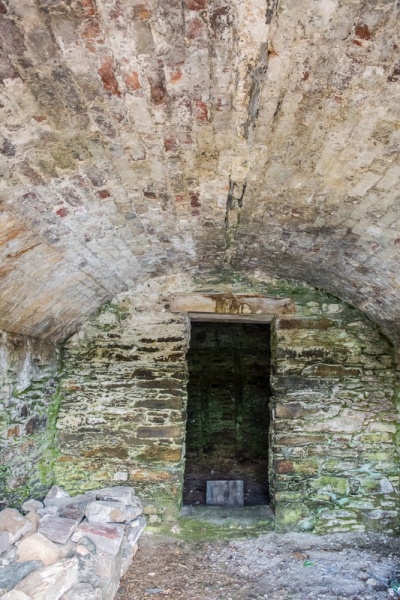
Inside the ammunition storehouse
Getting There
The fort is located a short walk downhill from the free parking area on the A487 coastal road, at the eastern edge of Fishguard. The small (16 vehicles) parking area is at the top of the hill outside Old Fishguard (Lower Town). From the car park just follow the signposted trail that winds north and downhill and the fort will come into view below you after 100 yards.
The fort is directly on the Pembrokeshire Coast Path National Trail and Wales Coast Path.
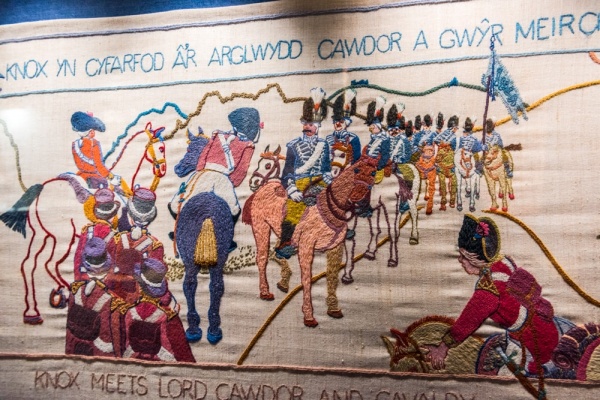
The Last Invasion Tapestry at Fishguard Library
More Photos
Location: At the top of the hill east of Old Fishguard, on the A487.
Website: Fishguard Fort -
Pentre Ifan Burial Chamber, Nevern, Crymych SA41 3TZ, UK
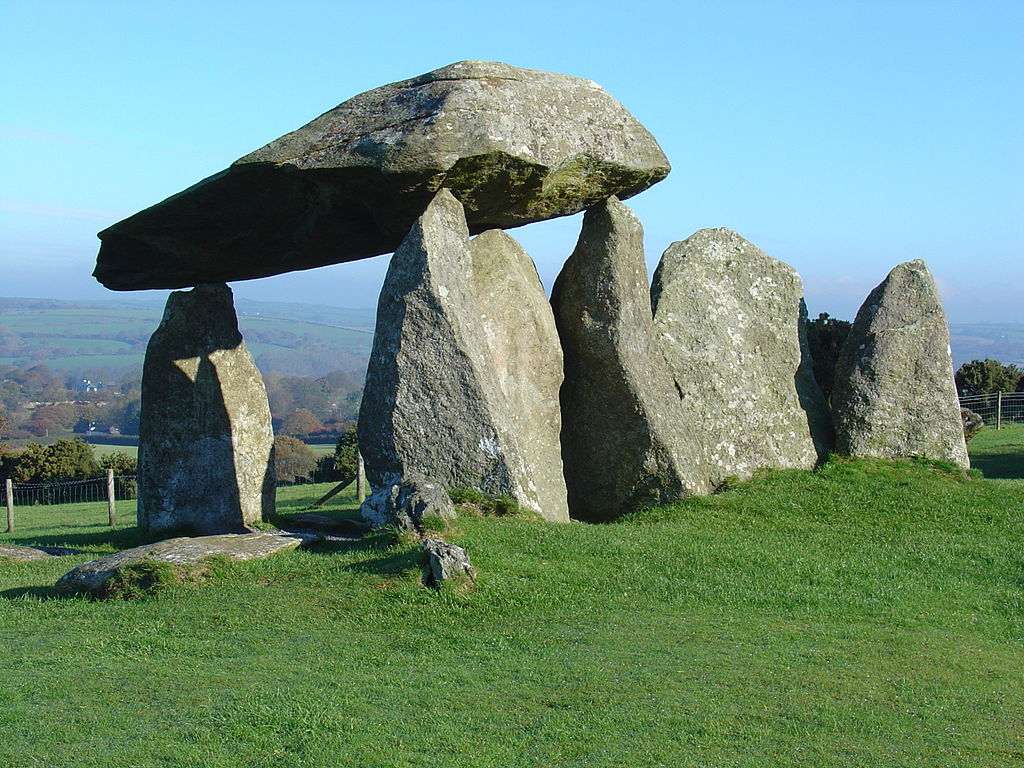
Pentre Ifan is the name of an ancient manor in the community and parish of Nevern, Pembrokeshire, Wales. It contains and gives its name to the largest and best preserved neolithic dolmen in Wales. The Pentre Ifan monument is a Scheduled Ancient Monument and was one of three Welsh monuments to receive legal protection under the Ancient Monuments Protection Act 1882.
The dolmen is maintained and cared for by Cadw, the Welsh Historic Monuments Agency. It is about 11 miles (18 km) from Cardigan, and 3 miles (5 km) east of Newport, Pembrokeshire.
The dolmen dates from around 3500 BC, and has traditionally been identified as a communal burial. Under this theory the existing stones formed the portal and main chamber of the tomb, which would originally have been covered by a large mound of stones about 30 m (98 ft) long and 17 m wide. Some of the kerbstones, marking the edge of the mound, have been identified during excavations. The stone chamber was at the southern end of the long mound, which stretched off to the north. Very little of the material that formed the mound remains. Some of the stones have been scattered, but at least seven are in their original position. An elaborate entrance façade surrounding the portal, which may have been a later addition, was built with carefully constructed dry stone walling. Individual burials are thought to have been made within the stone chamber, which would be re-used many times. No traces of bones were found in the tomb, raising the possibility that they were subsequently transferred elsewhere.
Pembrokeshire Candle Centre
3 Upper W St, Newport SA42 0QN, UK
THE PEMBROKESHIRE CANDLE CENTRE, LOCATED IN THE HAMLET OF CILGWYN ABOUT TWO MILES FROM NEWPORT (PEMBS), IS THE HOME BASE OF CILGWYN CANDLES, A SMALL BUSINESS SET UP BY INGER JOHN AND HER HUSBAND BRIAN IN 1976.In 2019, WE CELEBRATE THE 43rd ANNIVERSARY OF THE BUSINESS, HAVING PROVIDED A UNIQUE SHOPPING AND VISITOR EXPERIENCE FOR MORE THAN 10,000 PEOPLE EACH YEAR.ON THE SITE WE HAVE A WORKSHOP WHERE INGER MAKES HAND-DIPPED AND OTHER TYPES OF CANDLES, A MINI-MUSEUM WITH DISPLAYS RELATING TO CANDLE-MAKING OVER THE CENTURIES, AND A DISPLAY AREA DEVOTED TO CANDELABRAS AND COMMISSIONED ITEMS.
The candle-making business at Cilgwyn was started by Inger and Brian John when they moved to the area from County Durham. Inger has always been the candle-maker, and Brian has provided the moral support as well as humping tonnes of wax about and building display stands for craft fairs etc. Partnership is the name of the game.At first, the business was run from a lock-up garage across the yard from the house, but in 1982 the garage was demolished and a new building put up in its place. This building now houses the workshop and the mini-museum downstairs and the gallery upstairs. Space is very tight, and there is only room for one person to make candles at a time.The essential items of candle-making equipment in the workshop are a boiler for holding water and molten wax, a simple rack which can be lifted up by a pulley when candles need to be trimmed, and lots of metal coat-hangers from the dry cleaners. There is also a small heating ring for melting small quantities of wax in a saucepan. That is all! Not exactly high-tech, but candle-making is a craft, and the candles which Inger makes are successful and very beautiful because she has a steady hand, an instinct for colour combinations, and an encyclopaedic knowledge of how molten wax behaves.In the early days of the business, Inger sold most of her dipped candles through the trade, supplying to craft shops and gift shops all over the UK and further afield. Gradually, however, the workshop began to attract visitors, and after many years of building up the business over 10,000 people call at the workshop each year.The Pembrokeshire Candle Centre is now one of the prime visitor attractions in North Pembrokeshire, and most of the annual output of candles is sold straight from the premises to new visitors and faithful “regulars” who call again and again and again.......
One of the most beautiful things about candles is that they are meant to be destroyed. And once they have brightened up somebody’s life and have faded away, they need to be replaced!
Pembrokeshire Candle Centre-Trefelin, Cilgwyn, Newport,Pembrokeshire SA42 0QN
Tel 01239 -- 820470 Email: cilgwyn4@mac.com
How to find us-We are at Cilgwyn bridge, about 2 miles from Newport. Follow the brown signs from A487 at the east end of Newport, or from the B4329 at Tafarn-y-Bwlch.
Your visit to the Pembrokeshire Candle Centre will also give you a chance to discover one of Pembrokeshire’s most beautiful secret valleys. The hamlet of Cilgwyn lies in a sheltered hollow at the entrance to Cwm Gwaun and beneath the rocky peak of Carn Ingli -- right at the heart of Bluestone Country.Inger John provides a warm welcome to all visitors, who can see hand-dipped candles being made without any mechanical aids. Her candles are created with unique graded colours and with exotic scents including specially blended essential oils.The workshop is a real “Aladdin’s Cave” packed with candles of all shapes and sizes; most are made on the premises, and others are imported from all over the world. Also in stock are candlesticks of many types, snuffers, lanterns, oil burners, accessories, candle-making kits, and books of local interest. We try to keep a constant eye on the latest trends, so there is always something new when you next call.Next to the workshop is Britain’s smallest museum, with fascinating displays relating to the history and traditions of candle-making right back to Roman times.Incorporated into our sales area are some larger and unique items designed for enlightenment -- candlesticks, candelabra, wall sconces, floor-standing candle holders, and specially-commissioned items from local craftsmen and artists.
2019 Opening times: Easter - end of October, 11 am - 5 pm, Monday to Friday. Closed on Saturdays and Sundays, unless we just happen to be open! Ring 01239-820470 to check.

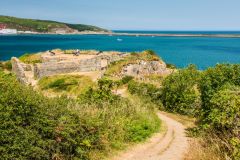
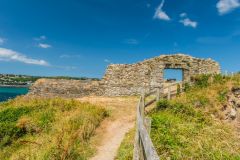
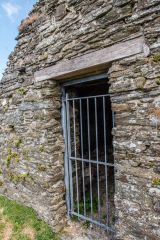
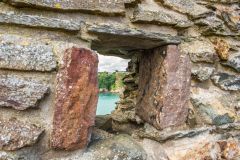
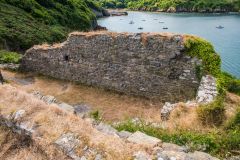
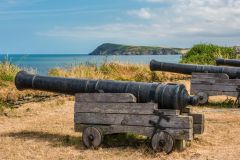
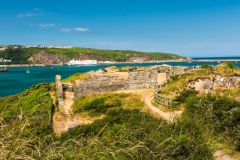


No comments:
Post a Comment